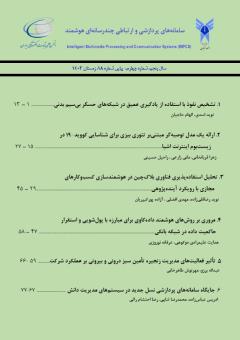استخراج ویژگی و طبقه بندی ضایعات کولونوسکوپی بر اساس چارچوب HCBA
محورهای موضوعی : پردازش چند رسانه ای، سیستمهای ارتباطی، سیستمهای هوشمند
وحید بایرامی راد
1
![]() ,
مهدی مزینانی
2
*
,
مهدی مزینانی
2
*
![]() ,
میترا میرزارضایی
3
,
میترا میرزارضایی
3
![]()
1 - دانشجوی دکتری، گروه مهندسی کامپیوتر، واحد علوم و تحقیقات، دانشگاه آزاد اسلامی، تهران، ایران
2 - دانشیار، گروه مهندسی برق و الکترونیک، ,واحد شهرقدس، دانشگاه آزاد اسلامی، تهران، ایران.
3 - دانشیار، گروه مهندسی کامپیوتر، واحد علوم و تحقیقات، دانشگاه آزاد اسلامی، تهران، ایران
کلید واژه: کولونوسکوپی, ضایعات کولون, یادگیری عمیق, پردازش تصویر, طبقه بندی,
چکیده مقاله :
سرطان روده یک بیماری کشنده است ، که به دلیل ناهگن بودن سلولهای سرطانی ،طبقه بندی آن برای پزشکان یک کار چالش برانگیز است . در سالهای اخیر، استفاده از تکنیکهای رایانهای، بهویژه پردازش تصویر و ویدئو با الگوریتمهای هوش مصنوعی ادغامشده در زمینههای پردازش تصاویر پزشکی و کاربردهای مرتبط با سلامت مورد توجه قرار گرفته است و تحقیقات زیادی در این زمینه صورت گرفته است. به عنوان مثال، تشخیص و طبقهبندی ضایعات کولون در کولونوسکوپی یکی از زمینههایی است که میتوان با استفاده از پردازش تصویر و الگوریتمهای هوش مصنوعی، دقت تشخیص را افزایش داد و به پزشک کمک کرد تا ضایعات را با دقت بیشتری شناسایی و طبقهبندی کند. بنابراین در این مقاله، یک چارچوب یادگیری عمیق جدید به نام HCBA برای استخراج ویژگی ضایعات کولونوسکوپی که از چندین روش مانند خوشهبندی سلسله مراتبی بهینه شده ، کوله ای از ویژگیهای بهینه شده و رمزگذار خودکار عمیق تشکیل شدهاندو برای طبقه بندی ضایعات کولونوسکوپی از شبکه باور عمیق استفاده شده ، پیشنهاد میشود .در نهایت با توجه به نتایج تجربی، عملکرد روش پیشنهادی در طبقهبندی تصاویر کولونوسکوپی با در نظر گرفتن معیار دقت به تصویر کشیده شده است.
Abstract
Introduction: Recent years have witnessed expansion of colon-related diseases expanding due to the expansion of modern lifestyles. Fortunately, early diagnosis of these diseases can significantly facilitate the treatment and control of these diseases. A novel deep learning framework, HCBA, was introduced to classify colonoscopy lesions. The framework consists of several methods such as hierarchical clustering, a bag of features, and an auto-encoder.
Method: Feature extraction was done using BOF and autoencoder, where hierarchical clustering and colonoscopy lesion classification were performed using DBN.
Results: The proposed method had a high performance in classifying colonoscopy images. The method exhibited the highest mean results in HCBA-DBN, including 93.0 in ACC, 87.1 in Pre, 87.6 in Rec, and 94.8 in Sen.
Discussion: The extraction of features was based on a set of features and hierarchical clustering was optimized. The separation of the similarity measurement between the samples within the cluster was based on the standard deviation. In addition, deep belief learning was used.
1. Jheng, Y.-C., et al., A novel machine learning-based algorithm to identify and classify lesions and anatomical landmarks in colonoscopy images. Surgical Endoscopy, 2022. 36: p. 640-650.
2. Zhang, R., et al., Automatic detection and classification of colorectal polyps by transferring low-level CNN features from nonmedical domain. IEEE journal of biomedical and health informatics, 2016. 21(1): p. 41-47.
3. ELKarazle, K., et al., Detection of colorectal polyps from colonoscopy using machine learning: A survey on modern techniques. Sensors, 2023. 23(3): p. 1225.
4. Wimmer, G., et al., Fisher encoding of convolutional neural network features for endoscopic image classification. Journal of Medical Imaging, 2018. 5(3): p. 034504-034504.
5. Cherubini, A., A novel AI device for real-time optical characterization of colorectal polyps.
6. Gong, E.J., et al., No-code platform-based deep-learning models for prediction of colorectal polyp histology from white-light endoscopy images: development and performance verification. Journal of Personalized Medicine, 2022. 12(6): p. 963.
7. Biffi, C., et al., A novel AI device for real-time optical characterization of colorectal polyps. NPJ digital medicine, 2022. 5(1): p. 84.
8. Zhou, J., et al., Feature fusion for diagnosis of atypical hepatocellular carcinoma in contrast-enhanced ultrasound. IEEE Transactions on Ultrasonics, Ferroelectrics, and Frequency Control, 2021. 69(1): p. 114-123.
9. Chen, C., et al., Domain knowledge powered deep learning for breast cancer diagnosis based on contrast-enhanced ultrasound videos. IEEE Transactions on Medical Imaging, 2021. 40(9): p. 2439-2451.
10. Guo, Z., et al. Automatic polyp recognition from colonoscopy images based on bag of visual words. in 2017 IEEE 8th International Conference on Awareness Science and Technology (iCAST). 2017. IEEE.
11. Saluja, K., et al. Efficient bag of deep visual words based features to classify CRC images for colorectal tumor diagnosis. in 2022 2nd international conference on advance computing and innovative technologies in engineering (ICACITE). 2022. IEEE.
12. Nawarathna, R., et al., Abnormal image detection in endoscopy videos using a filter bank and local binary patterns. Neurocomputing, 2014. 144: p. 70-91.
13. Huang, H. and Y. Ma, A hybrid clustering approach for bag-of-words image categorization. Mathematical Problems in Engineering, 2019. 2019: p. 1-11.
14. Stasiowski, M.J., et al., Adequacy of anesthesia guidance for colonoscopy procedures. Pharmaceuticals, 2021. 14(5): p. 464.
15. Wang, D., et al., Afp-mask: Anchor-free polyp instance segmentation in colonoscopy. IEEE Journal of Biomedical and Health Informatics, 2022. 26(7): p. 2995-3006.
16. Tian, Y., et al., Detecting, localizing and classifying polyps from colonoscopy videos using deep learning, in Deep Learning for Medical Image Analysis. 2024, Elsevier. p. 425-450.
17. Hossain, M.S., et al., Deeppoly: deep learning based polyps segmentation and classification for autonomous colonoscopy examination. IEEE Access, 2023.
18. Ma, C., et al. A Real-Time Polyp Detection Framework for Colonoscopy Video. in Chinese Conference on Pattern Recognition and Computer Vision (PRCV). 2022. Springer.
19. Nisha, J., V.P. Gopi, and P. Palanisamy, Automated colorectal polyp detection based on image enhancement and dual-path CNN architecture. Biomedical Signal Processing and Control, 2022. 73: p. 103465.
20. Carrinho, P. and G. Falcao, Highly accurate and fast YOLOv4-Based polyp detection. Expert Systems with Applications, 2023. 232: p. 120834.
21. Krenzer, A., et al., A real-time polyp-detection system with clinical application in colonoscopy using deep convolutional neural networks. Journal of imaging, 2023. 9(2): p. 26.

